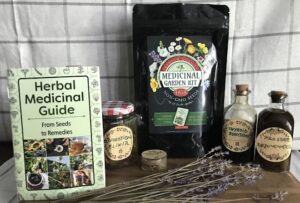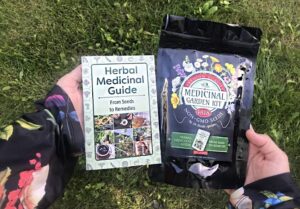What if you could turn a small corner of your New York backyard—or even a sunny windowsill in your city apartment—into a mini pharmacy filled with natural remedies? From the busy streets of Manhattan to the peaceful landscapes of the Hudson Valley and upstate, New Yorkers are rediscovering what our grandparents always knew: the healing power of plants.
The great thing is, you don’t need acres of farmland or expert-level gardening skills. New York’s climate—cold winters, humid summers, and fertile soil—is actually perfect for growing a variety of medicinal herbs that can help with stress, sleep, immunity, digestion, and more.
In this guide, we’ll explore 10 of the best medicinal herbs you can grow in New York. Some are familiar favorites like chamomile and peppermint, while others—like valerian, bee balm, and yarrow—are hidden gems uniquely suited for this region. Along with each herb, you’ll learn how to plant it, how to care for it, its proven health benefits, and one simple remedy you can make at home.
By the end, you’ll see just how easy it is to grow your own backyard pharmacy—no matter if you live in the city or the countryside. 🌱
🌦️ Understanding New York’s Climate for Medicinal Herbs
Before we get into the herbs themselves, it’s important to know how New York’s climate affects what you can grow. Unlike some states with mild year-round weather, New York has four very distinct seasons, which means your herbs need to be chosen (and cared for) with that in mind.
Here’s a quick breakdown of what gardeners in New York can expect:
- Climate Type: Humid continental (cold winters, hot summers, moderate rainfall)
- Average Rainfall: Around 40 inches per year, fairly well-distributed across the seasons
- Summer Temperatures: Warm and humid, usually 75°F to 85°F (24°C–29°C)
- Winter Temperatures: Cold, often below freezing, especially upstate
- Growing Season: Typically 150–180 days (mid-May to mid-October, depending on the region)
✅ What This Means for Your Herb Garden
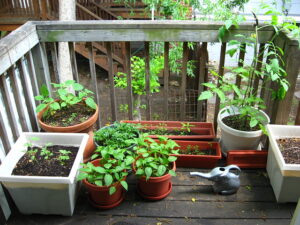
- Hardy perennials like echinacea, sage, and yarrow do very well because they survive cold winters and come back each spring.
- Delicate herbs like aloe vera and lemongrass need to be grown in pots indoors once frost arrives.
- Moisture-loving herbs (such as peppermint and lemon balm) thrive in New York’s humid summers.
- The shorter growing season means starting seeds indoors in March or April gives you a big head start before transplanting outdoors in May.
In short: New York’s climate is challenging but rewarding. With the right mix of hardy and adaptable herbs, you can enjoy fresh remedies all summer—and some will keep giving year after year.
1. Chamomile – The Calming Classic

Chamomile (Matricaria chamomilla) is one of the most trusted and widely used medicinal herbs in the world, and the good news is—it grows beautifully in New York. Known for its delicate daisy-like flowers, chamomile has been used for centuries to calm stress, aid digestion, and promote restful sleep.
🌿 Benefits (Backed by Science)
- Sleep & Relaxation → Chamomile contains apigenin, a compound that binds to receptors in the brain and promotes sleepiness (NIH – NCCIH).
- Digestive Support → Chamomile tea is often used to soothe indigestion, bloating, and nausea (PubMed).
- Anti-Inflammatory → Flavonoids and antioxidants in chamomile reduce inflammation and support overall wellness (PubMed).
🌱 How to Plant & Maintain Chamomile in New York
- Planting Time: Sow seeds indoors in March–April; transplant outdoors after the last frost (usually mid-May).
- Soil & Light: Prefers well-drained soil and full sun, but tolerates partial shade during hot summer days.
- Watering: Light but regular watering; keep soil moist but not soggy.
- Timeline:
- Germination: 7–14 days
- Ready to harvest flowers in 6–8 weeks
- Maintenance: Deadhead spent blooms to encourage more flowers through summer.
🍵 Simple Remedy: Chamomile Bedtime Tea
- Steep 1–2 teaspoons of dried chamomile flowers in hot water for 10 minutes.
- Sip before bed to promote relaxation and deeper sleep.
- Backed by research: Chamomile tea has shown effectiveness in improving sleep quality in older adults (PubMed).
✅ Chamomile is one of the easiest herbs to grow in New York’s climate, and with just a few pots or a garden patch, you can enjoy a steady supply of fresh, calming tea all summer long.
2. Echinacea – The Immunity Booster
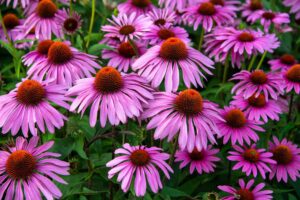
Echinacea (commonly called Purple Coneflower) is not only one of the most beautiful perennials for New York gardens—it’s also one of the most researched medicinal herbs in the world. Native to North America, echinacea has a long history of use among Indigenous peoples and remains popular today for immune support and fighting colds.
🌿 Benefits (Science-Backed)
- Boosts Immunity → Research suggests echinacea extracts may reduce the risk of recurrent respiratory infections and slightly shorten the duration of colds (NIH – NCCIH).
- Anti-Inflammatory & Antioxidant → Contains compounds like cichoric acid and alkamides, which reduce inflammation and oxidative stress (PubMed).
- Wound Healing → Traditionally applied topically to support skin healing.
🌱 How to Plant & Maintain Echinacea in New York
- Planting Time: Start seeds indoors 8–10 weeks before last frost (March), or transplant young plants outdoors in May.
- Soil & Light: Prefers well-drained soil and full sun (at least 6 hours/day).
- Watering: Low water needs once established—echinacea is drought-tolerant.
- Timeline:
- Germination: 10–20 days
- First blooms: Usually in the second year of growth
- Maintenance: Hardy perennial (zones 3–9), perfect for New York winters. Cut stems back in late fall, and plants regrow each spring.
🍵 Simple Remedy: Echinacea Immune Tea
- Add 1–2 teaspoons of dried echinacea root or leaves to boiling water.
- Simmer for 10 minutes and strain.
- Drink at the first sign of a cold or during flu season.
- Backed by evidence: Some studies show echinacea can shorten the duration of colds in adults (NIH – NCCIH).
✅ Echinacea isn’t just a hardy plant—it’s a long-term investment in your garden and health, thriving year after year while giving you one of nature’s best immune allies.
3. Calendula – The Skin Healer
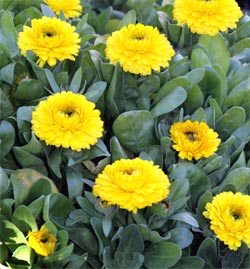
Calendula (Calendula officinalis), also called pot marigold, is a bright, golden flower that’s as useful in the medicine cabinet as it is beautiful in the garden. In New York, calendula thrives during the warm growing season and can easily reseed itself for the following year.
🌿 Benefits (Backed by Research)
- Wound Healing → Calendula accelerates skin repair and reduces inflammation (PubMed).
- Anti-Inflammatory → Rich in flavonoids and carotenoids, which help reduce swelling and redness (NIH – NCCIH).
- Antimicrobial → Used to prevent infection in minor cuts, scrapes, and burns.
- Skin Care → Widely used in creams and salves for eczema, rashes, and dry skin.
🌱 How to Plant & Maintain Calendula in New York
- Planting Time: Direct sow seeds outdoors in late April–May after the last frost, or start indoors in March.
- Soil & Light: Grows in average, well-drained soil. Prefers full sun, but tolerates partial shade in hot summers.
- Watering: Moderate needs—water when soil feels dry. Avoid soggy soil.
- Timeline:
- Germination: 7–14 days
- Blooms: Within 6–8 weeks, continues flowering until frost.
- Maintenance: Deadhead regularly to encourage more blooms. Self-seeds easily, meaning you’ll often see new plants next year.
🧴 Simple Remedy: Calendula Healing Salve
- Instructions:
- Dry calendula flowers and infuse them in olive oil for 2–3 weeks.
- Strain and mix the oil with melted beeswax.
- Store in a small jar.
- Use: Apply to cuts, burns, or dry skin as a natural healing ointment.
- Why It Works: Calendula’s triterpenoids and flavonoids promote faster tissue repair (PubMed).
✅ Calendula is a low-maintenance, high-value herb—it brightens your garden while giving you one of the best natural skin remedies you can grow at home in New York.
4. Valerian Root – The Natural Sleep Aid
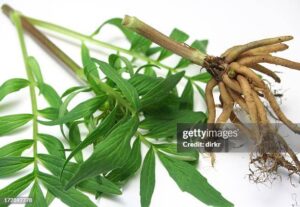
Valerian (Valeriana officinalis) is a perennial herb famous for its ability to improve sleep and reduce anxiety. While its flowers are small and delicate, the real magic lies in the roots, which have been used in Europe and North America for centuries as a natural sedative. In New York’s climate, valerian grows very well in moist, rich soil and is hardy enough to survive freezing winters.
🌿 Benefits (Research-Backed)
- Improves Sleep Quality → Studies suggest valerian root may reduce the time it takes to fall asleep and improve sleep quality (NIH – NCCIH).
- Reduces Anxiety & Stress → Acts on GABA receptors in the brain, similar to how anti-anxiety medications work, but more gently (PubMed).
- Menstrual Relief → May ease cramps and discomfort due to its muscle-relaxing properties.
🌱 How to Plant & Maintain Valerian in New York
- Planting Time: Sow seeds or root divisions in spring (April–May) after the last frost.
- Soil & Light: Prefers moist, fertile soil and partial to full sun.
- Watering: Keep soil consistently moist, especially in summer.
- Timeline:
- Germination: 2–3 weeks
- Roots harvestable in the second year (after 18–24 months).
- Maintenance: Hardy perennial (zones 4–9). Cut back in winter; regrows in spring.
🍵 Simple Remedy: Valerian Root Sleep Tea
- Instructions:
- Dry valerian roots after 2 years of growth.
- Add 1 teaspoon dried root to hot water.
- Steep 10–15 minutes before bedtime.
- Why It Works: Valerian’s natural compounds (valerenic acid, isovaleric acid) interact with the brain’s calming pathways, supporting better sleep (NIH – NCCIH).
✅ Valerian is a hidden gem for New York gardeners—a hardy perennial that, with patience, rewards you with one of the most reliable natural sleep remedies available.
5. St. John’s Wort – The Mood Supporter
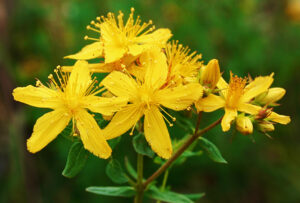
St. John’s Wort (Hypericum perforatum) is a bright yellow-flowering perennial long used in traditional medicine for mood support and mild depression. It grows abundantly in temperate climates like New York’s and is often found along fields, forest edges, and even roadsides. Cultivating it in your home garden gives you easy access to one of the most studied herbal remedies in modern herbal medicine.
🌿 Benefits (Backed by Research)
- Supports Mood & Reduces Mild Depression → Numerous studies have found St. John’s Wort to be more effective than placebo and nearly as effective as some antidepressants for mild to moderate depression (NIH – NCCIH).
- Anxiety & Sleep → May reduce anxiety symptoms and improve sleep in some users.
- Wound Healing → Used topically in oils and salves to aid skin repair.
⚠️ Important Note: St. John’s Wort can interact with certain medications (including antidepressants, birth control, and blood thinners). Always consult a healthcare provider before use.
🌱 How to Plant & Maintain St. John’s Wort in New York
- Planting Time: Sow seeds or plant cuttings in late spring (May–June).
- Soil & Light: Tolerates poor, sandy soils but grows best in well-drained soil with full sun.
- Watering: Drought-tolerant once established; water during prolonged dry spells.
- Timeline:
- Germination: 2–3 weeks
- Flowers: Appear in mid-summer (June–July)
- Maintenance: Hardy perennial (zones 4–9). Cut back stems after flowering. Self-seeds easily.
🌼 Simple Remedy: St. John’s Wort Oil for Skin & Mood Support
- Instructions:
- Collect fresh flowers in mid-summer.
- Infuse in olive oil for 2–3 weeks until the oil turns reddish.
- Use topically for cuts, bruises, and skin irritations.
- Why It Works: Contains hypericin and hyperforin, compounds studied for both mood support and topical healing (NIH – NCCIH).
✅ St. John’s Wort is a resilient, low-maintenance perennial for New York gardens, offering both emotional wellness support and topical healing remedies.
6. Yarrow – The Wound Healer
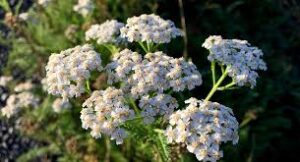
Yarrow (Achillea millefolium) is a native perennial to North America and Europe, and it has been used for centuries as a wound-healing and anti-inflammatory herb. It’s tough, cold-hardy, and grows beautifully in New York gardens, making it both a practical and ornamental addition. Its feathery leaves and clusters of tiny white or pink flowers also attract pollinators like butterflies and bees.
🌿 Benefits (Science-Backed)
- Wound Healing → Studies show yarrow extracts support faster blood clotting and wound closure (PubMed).
- Anti-Inflammatory → Contains flavonoids and sesquiterpene lactones, helping reduce swelling and muscle pain (NIH).
- Digestive Aid → Traditionally used for bloating, indigestion, and stomach cramps.
- Women’s Health → Sometimes used in teas to ease menstrual discomfort.
🌱 How to Plant & Maintain Yarrow in New York
- Planting Time: Direct sow outdoors in spring (April–May), or transplant nursery starts.
- Soil & Light: Prefers well-drained soil; thrives in full sun. Very tolerant of poor soil.
- Watering: Low water needs—drought-tolerant once established.
- Timeline:
- Germination: 7–14 days
- Flowers: First bloom in 8–10 weeks, continues through summer.
- Maintenance: Hardy perennial (zones 3–9). Cut back in fall; regrows in spring. Deadhead flowers for continuous blooms.
🌼 Simple Remedy: Yarrow Poultice for Cuts & Bleeding
- Instructions:
- Crush fresh yarrow leaves into a paste.
- Apply directly to minor cuts or scrapes to help stop bleeding.
- Why It Works: Yarrow contains achilleine, a compound that promotes blood clotting and tissue repair (PubMed).
✅ Yarrow is one of the hardiest medicinal plants for New York gardens. It requires almost no maintenance, attracts pollinators, and doubles as a powerful first-aid remedy straight from your backyard.
7. Bee Balm (Monarda) – The Cold & Throat Soother
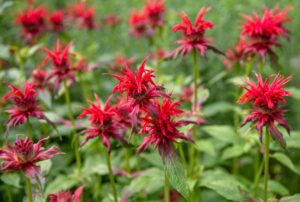
Bee Balm (Monarda didyma), also called Oswego Tea or Bergamot, is a native perennial to the Northeastern U.S., making it a perfect fit for New York gardens. With its bright red, purple, or pink flowers, bee balm not only adds beauty to your garden but also provides a powerful herbal remedy for colds, sore throats, and digestive issues.
🌿 Benefits (Backed by Tradition & Science)
- Respiratory Relief → Traditionally used by Native Americans to ease colds, coughs, and congestion (USDA Plants Database).
- Antimicrobial Properties → Contains thymol (also found in thyme), which has natural antibacterial effects (PubMed).
- Digestive Aid → Bee Balm tea has been used to soothe stomach cramps and indigestion.
- Calming Tea → Historically brewed into “Oswego Tea” as a caffeine-free alternative to black tea.
🌱 How to Plant & Maintain Bee Balm in New York
- Planting Time: Plant nursery starts or root divisions in spring (May) after frost danger passes.
- Soil & Light: Prefers rich, moist soil and full sun to partial shade.
- Watering: Needs regular watering—keep soil evenly moist.
- Timeline:
- Germination (if from seed): 14–21 days
- First blooms: Mid to late summer
- Maintenance: Hardy perennial (zones 3–9). Cut back stems in fall. Can spread aggressively—best to divide plants every 2–3 years.
🍵 Simple Remedy: Bee Balm Tea for Colds & Sore Throat
- Instructions:
- Harvest fresh bee balm leaves and flowers.
- Steep 1–2 teaspoons in hot water for 10 minutes.
- Sip warm to relieve sore throat and congestion.
- Why It Works: Bee balm’s thymol and essential oils help fight bacteria and soothe irritated throats (PubMed).
✅ Bee Balm is a New York native herb that’s both beautiful and medicinal. It not only supports respiratory health but also attracts hummingbirds, bees, and butterflies—making it a win for both your garden and your health.
8. Peppermint – The Digestive Powerhouse
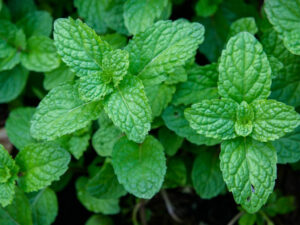
Peppermint (Mentha × piperita) is one of the most versatile and widely used medicinal herbs. In New York, it grows rapidly in the summer thanks to the state’s moist, humid climate. Because peppermint spreads quickly, it’s best grown in pots or containers to keep it under control.
🌿 Benefits (Science-Backed)
- Digestive Relief → Peppermint oil has been shown to ease irritable bowel syndrome (IBS), bloating, and indigestion (PubMed).
- Headache Relief → Menthol in peppermint oil can help relax muscles and relieve tension headaches (NIH – NCCIH).
- Antimicrobial → Naturally fights bacteria and fungi, supporting oral health.
- Respiratory Aid → Inhaled peppermint vapors can open airways and relieve congestion.
🌱 How to Plant & Maintain Peppermint in New York
- Planting Time: Plant cuttings or nursery starts in spring (May) after frost danger passes.
- Soil & Light: Thrives in moist, fertile soil with partial shade to full sun.
- Watering: Keep soil consistently moist; peppermint loves humidity.
- Timeline:
- Grows rapidly—ready to harvest within 6–8 weeks of planting.
- Maintenance: Perennial in New York (zones 3–9). Best grown in pots to prevent spreading invasively.
🍵 Simple Remedy: Peppermint Tea for Digestion
- Instructions:
- Steep 5–8 fresh peppermint leaves in hot water for 5–7 minutes.
- Sip after meals to ease bloating, gas, and indigestion.
- Why It Works: Peppermint’s menthol and essential oils relax digestive tract muscles, improving gut comfort (PubMed).
✅ Peppermint is one of the easiest herbs to grow in New York, thriving in pots or small garden patches. It’s a must-have for both culinary and medicinal use, especially for digestive and respiratory relief.
9. Sage – The Antimicrobial Memory Herb
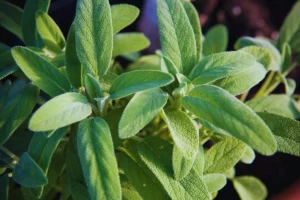
Sage is a perennial evergreen herb that thrives in New York’s climate when given full sun and well-drained soil. Beyond its culinary fame, sage has been valued for centuries for its antimicrobial, anti-inflammatory, and cognitive benefits. It’s also one of the hardiest herbs, surviving New York’s winters with minimal care.
🌿 Benefits (Research-Backed)
- Cognitive Support → Studies suggest sage may improve memory and mental clarity, even in people with Alzheimer’s (PubMed).
- Antimicrobial Power → Sage contains essential oils that inhibit bacteria, fungi, and viruses (NIH – NCCIH).
- Sore Throat & Oral Health → Sage tea or gargles help relieve sore throats and gum inflammation.
- Anti-Inflammatory → Natural compounds help reduce swelling and oxidative stress.
🌱 How to Plant & Maintain Sage in New York
- Planting Time: Sow seeds indoors in March–April or transplant outdoors in late May after frost.
- Soil & Light: Prefers well-drained, sandy soil with full sun.
- Watering: Low water needs—water deeply but infrequently. Sage dislikes soggy soil.
- Timeline:
- Germination: 2–3 weeks
- Ready for harvest in 2–3 months after planting.
- Maintenance: Hardy perennial (zones 4–9). Prune regularly to encourage new growth. Protect roots with mulch in harsh winters.
🍵 Simple Remedy: Sage Tea for Sore Throat
- Instructions:
- Add 1–2 teaspoons of dried sage leaves to hot water.
- Steep for 10 minutes.
- Drink warm or gargle to soothe sore throats.
- Why It Works: Sage’s antimicrobial essential oils help fight throat infections while its antioxidants reduce inflammation (NIH – NCCIH).
✅ Sage is a resilient, multipurpose herb for New York gardens—easy to grow, highly medicinal, and useful year-round in both food and natural remedies.
10. Wild Bergamot (Lemon Bee Balm) – The Stress & Cold Soother
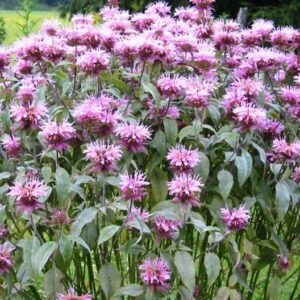
Wild Bergamot (Monarda fistulosa), also called Lemon Bee Balm, is a native perennial to New York and the broader Northeastern U.S. Its lavender-colored flowers and citrusy fragrance make it a favorite among pollinators—and herbalists. Traditionally used by Native American tribes, this herb is especially valued for respiratory health and stress relief.
🌿 Benefits (Backed by Research & Tradition)
- Respiratory Support → Used historically as a remedy for coughs, colds, and sore throats (USDA Plants Database).
- Antimicrobial & Antifungal → Contains thymol and essential oils with strong antimicrobial effects (PubMed).
- Stress & Anxiety Relief → Aromatic compounds help calm the nervous system and reduce tension.
- Digestive Aid → Traditionally brewed into tea to relieve bloating and indigestion.
🌱 How to Plant & Maintain Wild Bergamot in New York
- Planting Time: Sow seeds outdoors in spring (April–May) or plant divisions from established plants.
- Soil & Light: Prefers well-drained soil and full sun, though it tolerates partial shade.
- Watering: Moderate needs—water weekly in dry spells, but avoid soggy soil.
- Timeline:
- Germination: 10–20 days
- Flowers: Mid to late summer, lasting until early fall.
- Maintenance: Hardy perennial (zones 3–9). Cut back stems in late fall; regrows every year.
🍵 Simple Remedy: Wild Bergamot Cold & Stress Tea
- Instructions:
- Steep 2 teaspoons fresh or dried leaves/flowers in hot water for 10 minutes.
- Drink warm to relieve congestion and ease stress.
- Why It Works: Thymol and aromatic oils open airways and calm the body (PubMed).
✅ Wild Bergamot is not just a medicinal herb—it’s also a pollinator magnet, attracting bees, butterflies, and hummingbirds. For New Yorkers, it’s a perfect blend of beauty, resilience, and healing power.
🌱 Final Thoughts: Building Your Backyard Pharmacy in New York
From the peaceful farms of upstate to the cozy patios of Brooklyn brownstones, New Yorkers have the perfect climate to grow their own medicinal herbs. Hardy plants like echinacea, yarrow, and sage will come back year after year, while fragrant herbs like peppermint, chamomile, and bee balm thrive in New York’s humid summers. And with unique healing plants such as valerian and St. John’s Wort, you can create a natural medicine cabinet that truly supports your health and wellness—right from your backyard.
The best part? You don’t need to be an expert gardener. With just a few pots, sunlight, and a little care, you can grow herbs that calm stress, improve sleep, boost immunity, and heal everyday ailments.
🌿 Want to Grow All These Medicinal Herbs in New York Without the Guesswork?
Finding reliable seeds and knowing which herbs work best in New York’s climate can feel overwhelming. That’s why the Medicinal Garden Kit is the perfect solution.
👉 With the kit, you’ll get:
- 10 packs of heirloom, non-GMO medicinal seeds, carefully chosen to thrive in New York’s growing conditions.
- A step-by-step guidebook with 65+ easy remedies (teas, tinctures, salves, and more).
- 2 bonus resources on foraging and natural healing.
- A beginner-friendly system that works just as well in upstate gardens as it does in city balconies and pots.
💡 Whether you live in the countryside of the Hudson Valley or in a New York City apartment with a sunny windowsill, this kit makes it simple to create your very own backyard pharmacy.
👉 Click here to get your Medicinal Garden Kit and start growing your New York herbal garden today.
